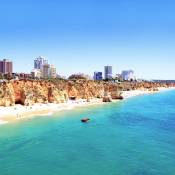Portugal is often thought of as a small, sunny country with lots of great beaches. That is without doubt, but dig a little deeper and you will find a country steeped in history and bursting with its own distinctive and proud culture.
Once one of the most powerful and richest nations in Europe, much of Portugal's fortune was sunk into indulgent monuments, grand architecture and fantastical palaces in and around Lisbon. Whilst this ultimately almost financially ruined the country it has left visitors spoiled for choice with so many things to do in Portugal.
If cities aren't your thing then there is stunning countryside a plenty on offer. Perhaps best known are the national park in Geres or the Douro Valley near Porto. For something in the middle try the magical town of Sintra with its hilltop, fairytale palace and ancient castle. And beach-lovers need not worry - the Algarve is lined with beautiful golden sand beaches and set up for family-fun.
We have created this list of the best things to do in Portugal based on our opinions. There are however an official 7 Wonders of Portugal chosen by the Portuguese public and a panel of eminent scholars. In honesty, a mere seven iconic sights doesn't do Portugal justice, so our list is a little longer.
One of the first and definitely grandest example of Manueline architecture to be found anywhere in Portugal; the Jerónimos Monastery in Belem is the embodiment of Portugal's exuberance during the Age of Discoveries. This is recognised in by the UNESCO World Heritage monument the monastery received in 1983.
Constructing such an opulent and grand building as the Jerónimos Monastery would have been extraordinarily expensive. However, it is no coincidence that the monastery was built to give thanks for the success of Vasco da Gama's...
No visit to Sintra would be complete without spending some time marvelling at the enchanting Palacio Nacional da Pena. This canary-yellow and terracotta coloured former palace is perched on a rocky outcrop overlooking the town and is an eclectic mix of different styles of architecture which somehow or other manage to blend beautifully together.
In the 16th century the building that stood here was a relatively humble monastery, dedicated to the Order of Saint Jerome and housing only 18 monks. The monastery was all but flattened by the powerful...
This former Knights Templar stronghold dates back to the 12th century. During the 15th and 16th centuries the monastery benefited from several Manueline additions including cloisters and the stunning chapterhouse window.
The Mosteiro de Batalha (Battle Abbey) was built to celebrate the important military victory of the Battle of Aljubarrota of 1385 in which Spanish forces were driven back. And celebrate they did! To describe the monastery as impressive would be somewhat of an understatement. It is on a par with the Mosteiro dos Jerónimos in Belém for both the scale and style. Like Jerónimos, Batalha features many Manueline style flourishes, but at the core is one of the best examples of Gothic architecture...
Reputed to be the oldest building in Lisbon, the cathedral (Sé de Lisboa) certainly has the appearance of being built to last. Compared to the frivolous Manueline architecture of the Jeronimos Monastery the Romanesque lines of the cathedral appear quite austere. Along with castellated walls and arrow slits in the towers Lisbon Cathedral, like other Portuguese cathedrals of the period, had the appearance of a fortress as much as a church.
Work began on the cathedral in 1147, the same...
The Santuário do Bom Jesus do Monte is located in Tenões, just outside Braga. It is apparently Portugal's most photographed church and there are a host of reasons for this.
Perhaps the most obvious is the incredible Baroque stairway that leads up to the hilltop church. The hill is 116 metres (381 feet) high and there are in the region of 580 steps which zig-zag to the top. Work began in the early 1720s and to call it a stairway is not really doing it justice. As the stairs ascend the mount there are a number of landings, on each of these are grottoes, fountains, allegorical statues...
The Tower in outstanding example of 16th c. Manueline architecture. Standing on the waterside at Belem it was built as both a celebration of the age of the Discoveries and to defend the mouth of the river.
This lavish, gothic-style mansion, set in equally fascinating grounds is close to the historic centre of Sintra. Known locally as the “palace of Monteiro the millionaire”, the estate was bought by Antonio Carvalho Monteiro, an altruistic, if rather eccentric entomologist with a fascination for all things esoteric. With the help of Italian architect Luigi Manini, he set about transforming the villa and surrounding estate into the intriguing place we see today.
The Regaleira Palace itself is built in the Neo-Manueline architectural style;...
The double-decker Dom Luis I bridge is an icon of the city of Porto. It spans the River Douro linking the Port wine houses of Vila Nova de Gaia with the bustling downtown Ribeira district of Porto. Construction took place between 1881 and 1886 with the bridge being built adjacent to an existing bridge which it replaced. The granite pillars of the original bridge are still in place, standing on the Ribeira like a pair of gate posts.
It is probably no coincidence that the bridge passes more than a fleeting resemblance of its neighbouring bridge, the...
The monastery of Santa Maria de Alcobaça is another UNESCO World Heritage site. This medieval monastery was the first to be built in the Gothic style in Portugal. Consists of many later additions and a a real insight into monastic life at the time.
Set atop a baroque staircase with 686 steps is the shrine and rococo church. To either side of the staircase is dense woodland with furtherr pathways and shrines
12. Évora Cathedral
Évora's imposing cathedral (Sé Catedral de Évora) is situated in the very heart of the old city and the UNESCO World Heritage site. The oldest parts of the building date back to the 12th century, which was when the Moors were finally driven out by the Christians. As a consequence it is no coincidence that this mighty cathedral has certain aspects which resemble a fortress. Probably most people's first view of the cathedral is the façade which looks out over the Évora's main square. The rose granite façade consists of the main entrance portal over which is an impressive Gothic window with...
13. Porto Cathedral

Porto Cathedral Pedro Paulo Palazzo | BY-SAThe fairly austere and imposing cathedral in Porto (Sé do Porto) was mostly built during the 12th and 13th centuries in the Romanesque style. However, it didn't really reach completion until the 16th century and even after this it was considerably remodelled and extended in the Baroque style.
Occupying the high ground to the east of the city, the cathedral looks westwards over the historic centre. From its commanding position the church does have something of a feel of a fortress about it - particularly the crenelations which run around the building, somewhat reflecting the...
Set high on the Serra de Sintra is the towns oldest monument, the Castleo dos Mouros (Moorish Castle). The ruined ramparts of this ancient castle hug the hilltop, spanning two of its highest pinnacles and incorporating the rocky outcrops into its walls. The castle is believed to date back to the 8th or 9th century when large swathes of Portugal were occupied by the Moors. However, the castle fell back under Christian rule when Portugal's first king, Afonso Henriques, reconquered it 1147. Aided by Scandinavian crusaders this was a major victory in the reconquest of Portugal and can't have...
Without doubt the most macabre of Faro's many attractions is the Capela dos Ossos (Chapel of the Bones), a minuscule ossuary chapel lovingly decorated with the bones and skulls of over 1000 human skeletons. The chapel forms part of the beautiful 18th century Igreja da Nossa Senhora do Carmo (Our Lady of Mount Carmel) Church, with its whitewashed Baroque exterior and richly gilded interior. Towards the back of the church, on the right hand side, a small door leads to a walled garden and this is where the Capela dos Ossos...
16. Marvão Castle
The whitewashed village of Marvão clings to the sides of a craggy granite peak of the Serra de São Mamede in the northern Alentejo. Crowning the 960 metre (3,000 ft) peak is the largely 13th century castle of Marvão.
It is fairly obvious why this position was chosen; the stunning sweeping views take in the mountainous terrain up to and beyond the Spanish border less than 15km (10 miles) away. In the words of Nobel laureate José Saramago, "From Marvão one can see the entire land", and this is not too much of an exaggeration. The first castle to be built in Marvão was by its founder,...
Stretching across the estuary at the Tagus River in Lisbon is the Ponte 25 de April (25th April Bridge); the largest suspension bridge in Europe and the 20th longest in the world. Often considered as a twin sister of the Golden Gate Bridge in San Francisco because of its similar design the bridge in Lisbon is actually 300 feet (100m) longer.
Officially opened in 1966 the Ponte 25 de April was considered the primary connection between north and south Portugal until the Vasco da Gama Bridge was built in 1998. Around this time works were carried out to suspend two railroad tracks under...
The Elevador de Santa Justa (Santa Justa lift) is a 47 metres (145ft) Lisbon's only remaining vertical elevator and connects Rua do Ouro in the Baixa to Largo do Carmo near Bairro Alto. It was built, along with several other cable powered urban lifts and funiculars, in a time before cars and the Metro. Whilst this may sound quite utilitarian and uninteresting nothing could be further from the truth.
Inaugurated in 1902, the elevator is a cast iron tower decorated with Neo-Gothic style filigrana details. Some say it is reminiscent of the Eiffel Tower in Paris, and this is not...
Situated only a short walk from the Ribeira and in Porto's historic centre this is by far the finest church. The Igreja de São Francisco (Church of St Francis) dates back to the 14th century when it was built as an enlargement to an existing church connected to the Franciscan convent. Constructed in the Gothic style the exterior is fairly modest compared to some of the Manueline excess of this period seen elsewhere. However, all this restraint is thrown to the wind when it comes to the interior.
...Built in the Baroque and neoclassical style the enormous palace / monastery dwarfs the town of Mafra. At the time of its construction in the 18th century this was one of the largest buildings in Europe
Still standing tall on Porto's skyline is the iconic Baroque bell tower and church of Clerigos. Rising over 75 metres from its already elevated position this slender granite tower was the tallest building in Porto when it was built in 1763. In fact it was not until 1999 that this was surpassed with the construction of the Hotel Vila Galé Porto.
Awarded Natural Park status in 1987, the Ria Formosa is a coastal lagoon protected by a group of sandy barrier islands. It features marshes, tidal flats, waterways and some excellent sandy beaches and is rich in marine and birdlife.
Regular boat trips take visitors out to explore Cultura Island with its fishing community, lighthouse and beaches and the uninhabited Barreta Island - known to the locals as the 'desert island'. These trips provide a wonderful opportunity to escape the crowds and get close up to...
23. Silves Castle
Silves' red sandstone castle, which dominates the town, was built by the Moors who held the Al-Gharb (Algarve) region from the 8th to 13th centuries. During this time, Silves (known at the time as Xelb) became an important centre of trading and culture and was the capital of the Al-Gharb. In the late 12th and early 13th centuries the town witnessed sieges, battles and much bloodshed as the Moors and Christians from the north fought over this strategically important site. The Muslims were finally expelled in 1249 and from this time onwards, as the river silted up, closing off trading...
24. Arco da Vila

Arco da Vila - Faro Morgan Davis | BY-SAFaro's fine neo-classical archway is the entrance to the Algarve city's old quarter (Cidade Velha). It was built on the site of a much older medieval gateway in the city walls by order of Bishop Francisco Gomes do Avelar in 1812. He oversaw much of the reconstruction of Faro after the devastating 1755 earthquake.
The design is the work of Genoese architect Francisco Xavier Fabri. Also hailing from Italy is the statue set in the recess above the arch - it is a figure of St Thomas Aquinas, a 13th century Italian religious scholar.
...
25. Cristo Rei
The statue of Cristo Rei (Christ the King) with his arms outstretched dominates the skyline of the far bank of the river from Lisbon. From the city it is hard to grasp quite how big this statue is, but it is huge. Set atop a 82m (270ft) plinth the figure of Christ measures nearly 30 metres (100ft) in height. This makes it marginally smaller than the Christ the Redeemer statue in Rio de Janeiro and there is no denying the obvious influences.
The pedestal upon which the figure stands is fairly impressive in its own right. It consists of four arches with the Chapel of Nossa Senhora da...




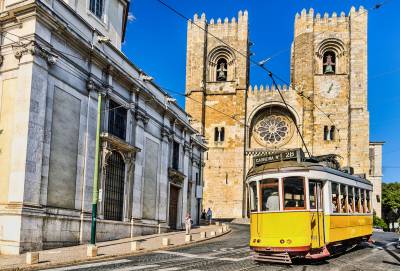
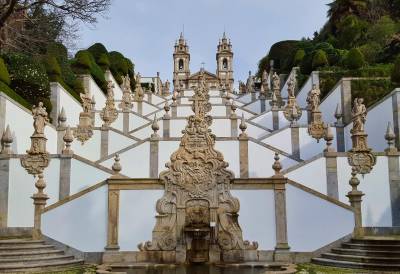


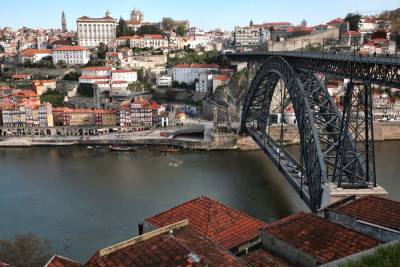

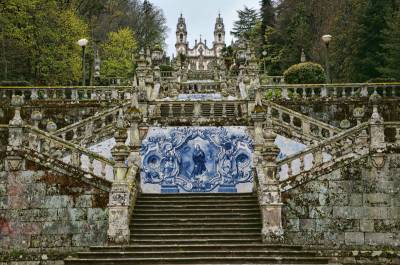














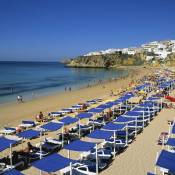 Albufeira
Albufeira
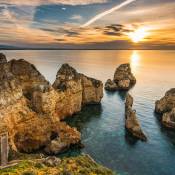

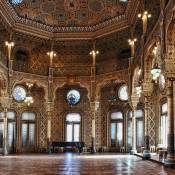


 Cascais
Cascais

